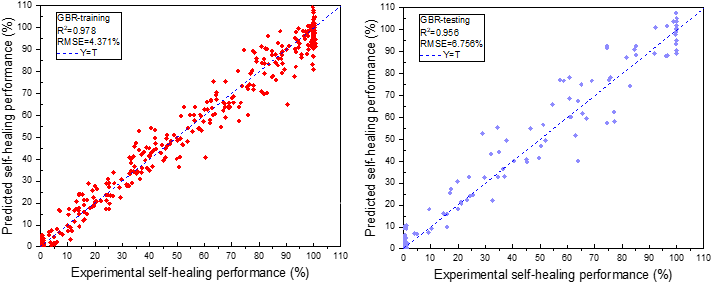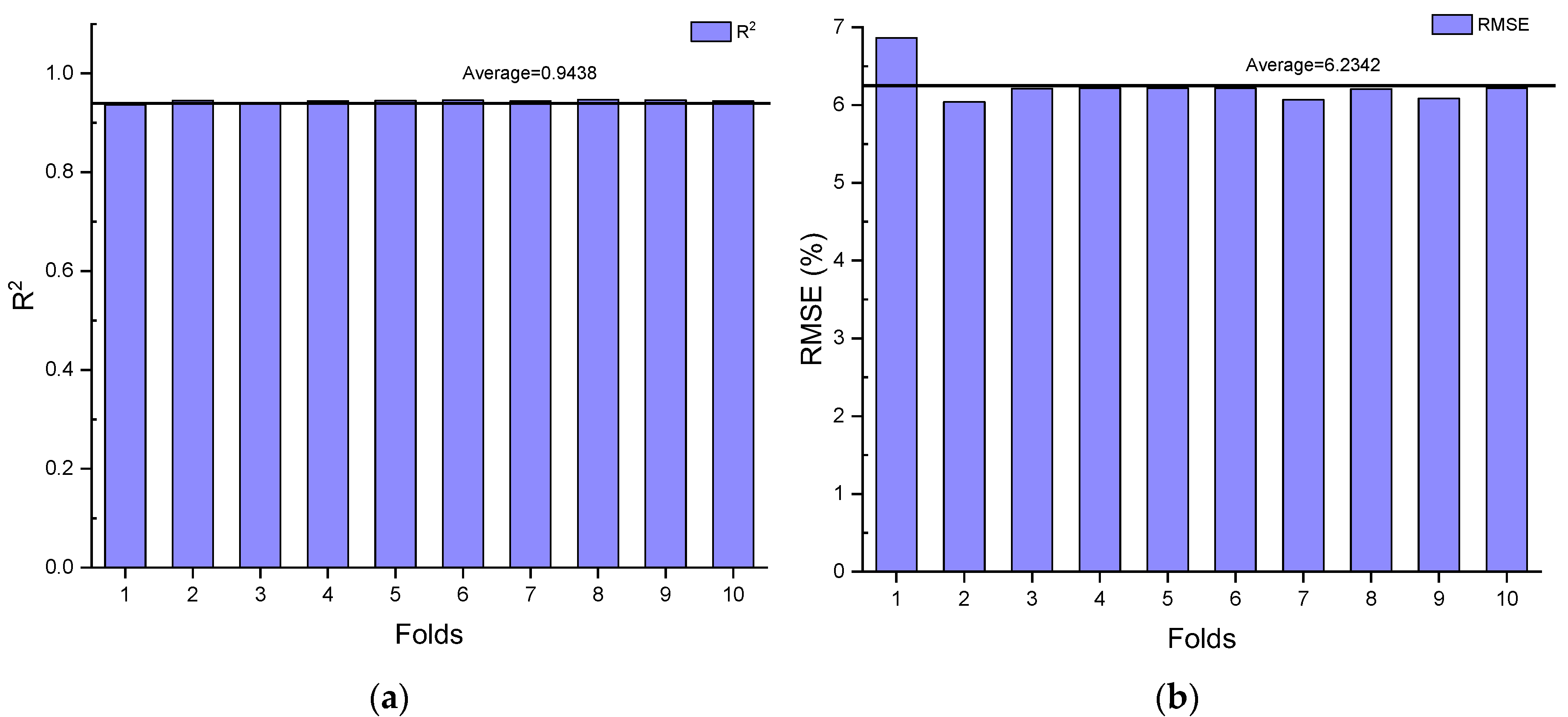Bacterial-based self-healing concrete (BSHC) is a well-known healing technology which has been investigated for a few decades for its excellent crack healing capacity. The healing performance (HP) of BSHC can be predicted using machine learning (ML) approaches to save the time and cost of laboratory tests, bacteria selection and healing mechanisms adoption.
- machine learning-aided prediction
- self-healing concrete
- bacterial-based self-healing concrete
1. Introduction
2.Methodology
2.1 Types of BSHC
Published articles related to BSHC between 2000 and 2021 are collected and analysed in this paper. According to the record, 15 types of bacteria have been employed for BSHC experiments as shown in Figure 1. Thereinto, Cyanobacteria, Synechococcus, Prochlorococcus Bacillus alkalinitrilicus, Bacillus subtilis, Bacillus cohnii, Pseudomonas aeruginosa and Bacillus mucilaginous belong to aerobic bacterial healing concrete. Bacillus pasteurii, Bacillus sphaericus, Bacillus megaterium and Diaphorobacter nitroreducens can be classified into nitrifying bacterial healing concrete. Bacillus cereus, Desulfovibrio brasiliensis and Desulfovibrio vulgaris can be concluded as ureolytic bacterial healing concrete and sulphate reduction biological mineralisation, respectively. It can be observed from Figure 1 that seven types of bacteria, i.e., Bacillus pasteurii, Bacillus sphaericus, Bacillus megaterium, Bacillus subtilis, Bacillus cereus, Bacillus alkalinitrilicus and Bacillus cohnii, have been employed more commonly. The rest of the bacteria, such as Cyanobacteria and Pseudomonas aeruginosa, have been utilised less than twice.
2.2 Data Preparation
A total of 797 data sets employed for predicting the HP of BSHC were collected from 14 articles published between 2000 and 2021[11][12][13][14][15][16][17][18][19][20][21][22][23][24]. Twenty-two variables influencing the HP of BSHC are employed in this paper to train ML models with the five algorithms. Six variables are used to describe the influencing factors of cementitious materials and water contents: the amount of fine aggregate (FA), the amount of coarse aggregate (CA), types of cement (TC), the amount of cement (CM), the water binder ratio (W/B) and the amount of superplasticiser (S). Furthermore, the eleven variables corelated with bacteria are the types of carriers (C), types of bacteria (B), dosages of bacteria (DB), types of BSHC (TBSHC), types of calcium ions sources (TCIS), dosages of calcium ions (DCI), types of carbon sources (TCS), dosages of carbon (DC), types of nutrients (TN), dosages of nutrients (DN) and dosages of urea (DU). All variables are represented by the mass ratio of concrete. Moreover, the initial cracking date (CD), the initial cracking width (CW), the healing time (HT), the healing condition (HC) and the healing test methods (HTM) are the variables with reference to the healing environment. Finally, the self-healing efficiency is represented by the healing performance (HP) as the unique output.2.3 Machine Learning Algorithms
In tThis paper, the e prediction ability of the five types of ML algorithms, GBR, RF, DNN, DTR and SVR, for predicting the HP of BSHC is studied. To achieve the best prediction ability, here a hyper-parameter tuning method named GSA is utilised to determine the optimal parameters of the ML models[25].3. Prediction Ability of ML Models


Figure 3. (a) R2 results and (b) RMSE results of GBR models with the 10-fold cross validation for predicting HP of BSHC.
In tThis paper, the e prediction ability of GBR is validated by employing 10-fold cross validation. The prediction ability (R2 and RMSE values) of the GBR models validated by different folds of the data sets is shown in Figure 3. Slight differences in R2 and RMSE values of the GBR models can be noticed in Figure 3a,b. For instance, 0.947 is the maximum R2 value of the GBR model at Fold 8, while 0.937 is the minimum R2 value of the GBR model at Fold 1. The rest of the R2 values are maintained at approximately 0.944. Furthermore, the RMSE value dramatically decreases from 6.864% to 6.039% between Fold 1 and Fold 2, followed by a slight growth to 6.210% at Fold 3. Subsequently, it keeps constant at 6.218% until Fold 6. It then fluctuates between 6.067% and 6.218% from Fold 7 to Fold 10.The average R2 and RMSE values of the GBR models with different folds of the data sets are 0.9438 and 6.2342%, respectively. Regarding the R2, RMSE and the statistical results of the GBR models, it can be concluded that the promising prediction ability of the GBR model for predicting the HP of BSHC is reliable.
4. Sensitivity Analysis

Figure 4. sensitivity analysis parameters of the variables.
In tThis paper, the e optimal ML model for predicting the HP of BSHC, GBR, is employed for sensitivity analysis (SA) to study the influence of variables on the output from quantitative analysis. With regard to the sensitivity analysis parameter (SAP) results shown in Figure 4, the following aspects can be concluded. Firstly, most of the variables related to cementitious materials and water, such as FA, CM and W/B, show a stronger influence on the HP of BHSC than that of the variables related to bacteria. This is because less water contained in the concrete results in more unreacted cement particles being retained for healing cracks. Furthermore, more FA can lead to the increased demand of water; thus, the HP of concrete with high FA is lower than that of concrete with low FA. It can be concluded that the influence of the variables on the HP of BSHC is CW ≥ water contents > HT > the variables related to bacteria. Secondly, the variables related to the healing environment, such as CW, HT and CD, were recognised as the significant influencing factors of HP[9][10]. However, there was no report to show the influencing degrees of the factors. In this paper, it can be observed from Figure 4 that the SAP of HT is 7.45%, 12.35% lower than that of CW. Moreover, the SAP of CW is more than three times that of CD. Thirdly, regarding the variables related to bacteria, DB has a higher effect than other variables on the HP of BSHC. The SAPs of the rest of the variables related to bacteria are close, excluding DC and DU, indicating a similar influence on the HP of BSHC. It can be observed from Figure 4 that DC and DU show little influence on the HP of BSHC.
References
- G.A. Habeeb; Moatasem Fayyadh; Rice Husk Ash concrete: The effect of RHA average particle size on mechanical properties and drying shrinkage. null 2009, Aust. J. Basic Appl. Sci, 1616-1622.
- Jonkers Hm; Bacteria-Based Self-Healing Concrete: Towards Standardization. Research & Development in Material Science 2019, 10, 1-3, 10.31031/rdms.2019.10.000732.
- M.M. Jensen; B. Johannesson; Mette Rica Geiker; A Coupled Chemical and Mass Transport Model for Concrete Durability. Proceedings of the Eighth International Conference on Engineering Computational Technology 2012, 100, 1-18, 10.4203/ccp.100.17.
- Howard Klee; Elaine Coles; The cement sustainability initiative– implementing change across a global industry. Corporate Social Responsibility and Environmental Management 2004, 11, 114-120, 10.1002/csr.59.
- Cailleux, E.; Pollet, V. Investigations on the development of self-healing properties in protective coatings for concrete and repair mortars. In Proceedings of the 2nd International Conference on Self-Healing Materials, Chicago, IL, USA, 28 June 2009; Volume 32, pp. 1–4.
- Xu Huang; Jun Ge; Sakdirat Kaewunruen; Qian Su; The Self-Sealing Capacity of Environmentally Friendly, Highly Damped, Fibre-Reinforced Concrete. Materials 2020, 13, 298, 10.3390/ma13020298.
- Kim Van Tittelboom; Nele De Belie; Self-Healing in Cementitious Materials—A Review. Materials 2013, 6, 2182-2217, 10.3390/ma6062182.
- Nele De Belie; Elke Gruyaert; Abir Al-Tabbaa; Paola Antonaci; Cornelia Baera; Diana Bajare; Aveline Darquennes; Robert Davies; Liberato Ferrara; Tony Jefferson; et al.Chrysoula LitinaBojan MiljevicAnna OtlewskaJonjaua RanogajecMarta Roig-FloresKevin PainePaweł ŁukowskiPedro SernaJean-Marc TullianiSnezana VuceticJianyun WangHenk M. Jonkers A Review of Self-Healing Concrete for Damage Management of Structures. Advanced Materials Interfaces 2018, 5, 1-28, 10.1002/admi.201800074.
- Xiaoying Zhuang; Shuai Zhou; The Prediction of Self-Healing Capacity of Bacteria-Based Concrete Using Machine Learning Approaches. Computers, Materials & Continua 2019, 59, 57-77, 10.32604/cmc.2019.04589.
- Ahmed Ramadan Suleiman; Moncef L. Nehdi; Modeling Self-Healing of Concrete Using Hybrid Genetic Algorithm–Artificial Neural Network. Materials 2017, 10, 135, 10.3390/ma10020135.
- Virginie Wiktor; Henk M. Jonkers; Quantification of crack-healing in novel bacteria-based self-healing concrete. Cement and Concrete Composites 2011, 33, 763-770, 10.1016/j.cemconcomp.2011.03.012.
- Mian Luo; Chun-Xiang Qian; Rui-Yang Li; Factors affecting crack repairing capacity of bacteria-based self-healing concrete. Construction and Building Materials 2015, 87, 1-7, 10.1016/j.conbuildmat.2015.03.117.
- Jiaguang Zhang; Cheng Zhao; Aijuan Zhou; Chao Yang; Lin Zhao; Zhu Li; Aragonite formation induced by open cultures of microbial consortia to heal cracks in concrete: Insights into healing mechanisms and crystal polymorphs. Construction and Building Materials 2019, 224, 815-822, 10.1016/j.conbuildmat.2019.07.129.
- Wasim Khaliq; Muhammad Basit Ehsan; Crack healing in concrete using various bio influenced self-healing techniques. Construction and Building Materials 2016, 102, 349-357, 10.1016/j.conbuildmat.2015.11.006.
- Jiaguang Zhang; Yuanzhen Liu; Tao Feng; Mengjun Zhou; Lin Zhao; Aijuan Zhou; Zhu Li; Immobilizing bacteria in expanded perlite for the crack self-healing in concrete. Construction and Building Materials 2017, 148, 610-617, 10.1016/j.conbuildmat.2017.05.021.
- Lu Jiang; Guanhua Jia; Chen Jiang; Zhu Li; Sugar-coated expanded perlite as a bacterial carrier for crack-healing concrete applications. Construction and Building Materials 2019, 232, 117222, 10.1016/j.conbuildmat.2019.117222.
- Lu Jiang; Guanhua Jia; Yongzhen Wang; Zhu Li; Optimization of Sporulation and Germination Conditions of Functional Bacteria for Concrete Crack-Healing and Evaluation of their Repair Capacity. ACS Applied Materials & Interfaces 2020, 12, 10938-10948, 10.1021/acsami.9b21465.
- Chao Liu; Xiaoyu Xu; Zhenyuan Lv; Lu Xing; Self-healing of Concrete Cracks by Immobilizing Microorganisms in Recycled Aggregate. Journal of Advanced Concrete Technology 2020, 18, 168-178, 10.3151/jact.18.168.
- Babar Saleem; Arshad Hussain; Afaq Khattak; Azam Khan; Performance evaluation of bacterial self-healing rigid pavement by incorporating recycled brick aggregate. Cement and Concrete Composites 2020, 117, 103914, 10.1016/j.cemconcomp.2020.103914.
- Gehad A. M. Metwally; Mohamed Mahdy; Ahmed El-Raheem H. Abd El-Raheem; Performance of Bio Concrete by Using Bacillus Pasteurii Bacteria. Civil Engineering Journal 2020, 6, 1443-1456, 10.28991/cej-2020-03091559.
- Yilin Su; Tianwen Zheng; Chunxiang Qian; Application potential of Bacillus megaterium encapsulated by low alkaline sulphoaluminate cement in self-healing concrete. Construction and Building Materials 2020, 273, 121740, 10.1016/j.conbuildmat.2020.121740.
- Momina Rauf; Wasim Khaliq; Rao Arsalan Khushnood; Iftikhar Ahmed; Comparative performance of different bacteria immobilized in natural fibers for self-healing in concrete. Construction and Building Materials 2020, 258, 119578, 10.1016/j.conbuildmat.2020.119578.
- Sandip Mondal; Aparna (Dey) Ghosh; Investigation into the optimal bacterial concentration for compressive strength enhancement of microbial concrete. Construction and Building Materials 2018, 183, 202-214, 10.1016/j.conbuildmat.2018.06.176.
- Anna M. Grabiec; Justyna Klama; Daniel Zawal; Daria Krupa; Modification of recycled concrete aggregate by calcium carbonate biodeposition. Construction and Building Materials 2012, 34, 145-150, 10.1016/j.conbuildmat.2012.02.027.
- Iwan Syarif; Adam Prugel-Bennett; Gary Wills; SVM Parameter Optimization using Grid Search and Genetic Algorithm to Improve Classification Performance. TELKOMNIKA (Telecommunication Computing Electronics and Control) 2016, 14, 1502, 10.12928/telkomnika.v14i4.3956.
